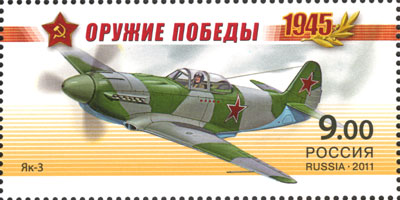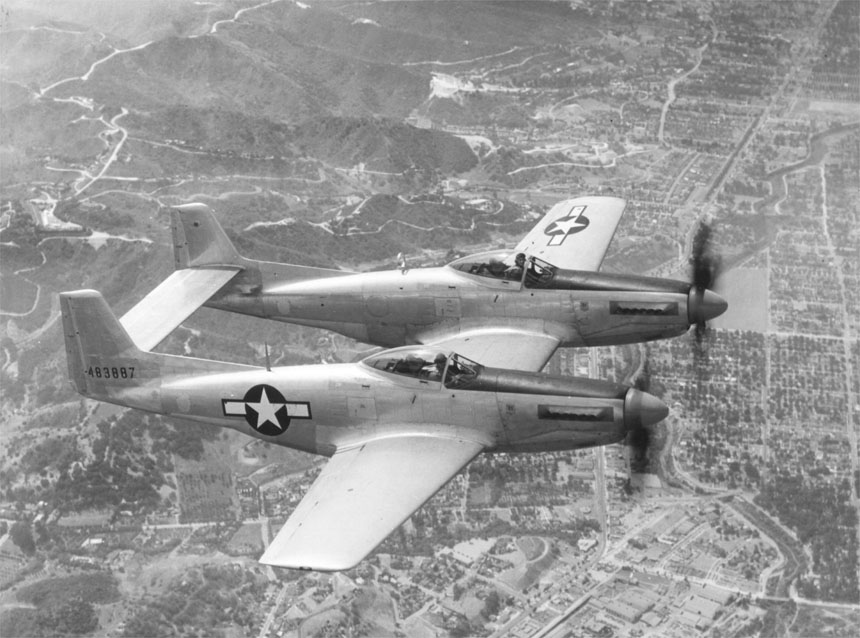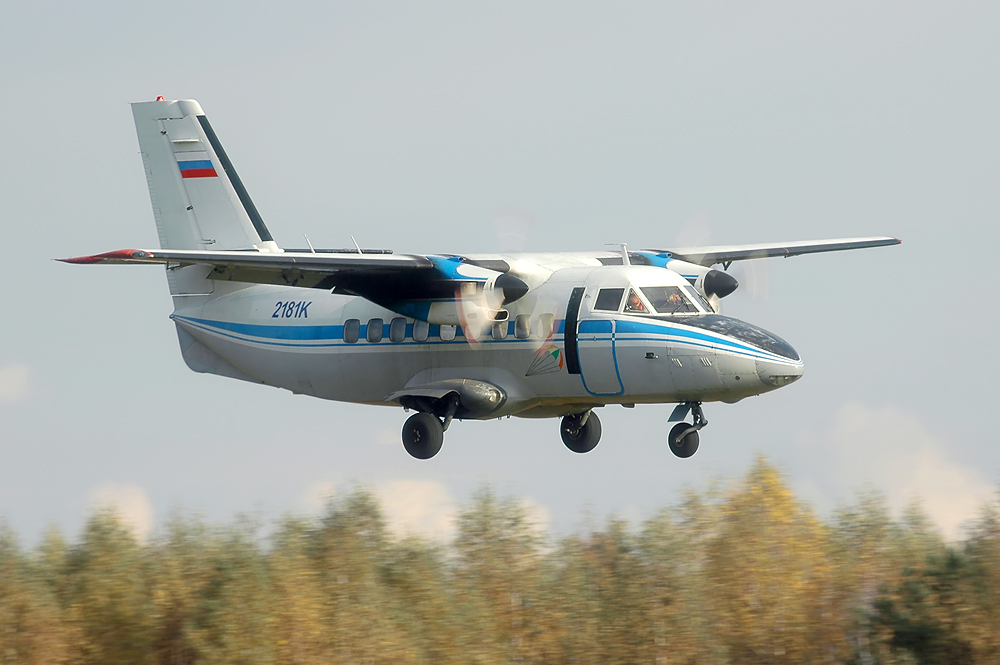|
Yak-11
The Yakovlev Yak-11 (russian: Яковлев Як-11; NATO reporting name: "Moose") is a trainer aircraft used by the Soviet Air Force and other Soviet-influenced air forces from 1947 until 1962. Design and development The Yakovlev design bureau began work on an advanced trainer based on the Yak-3 fighter in mid-1944, although the trainer was of low priority owing to the ongoing Second World War.Gunston 1995, p. 469. The first prototype of the new trainer, designated Yak-UTI or Yak-3UTI flew in late 1945. It was based on the radial-powered Yak-3U, but with the new Shvetsov ASh-21 seven-cylinder radial replacing the ASh-82 of the Yak-3U.Gordon Komissarov and Komissarov 2005, p. 249. It used the same all-metal wings as the Yak-3U, with a fuselage of mixed metal and wood construction. The pilot and observer sat in tandem under a long canopy with separate sliding hoods. A single synchronised UBS 12.7 mm machine gun and wing racks for two 100 kg (220 lb) bombs compris ... [...More Info...] [...Related Items...] OR: [Wikipedia] [Google] [Baidu] |
Yakovlev Yak-3
The Yakovlev Yak-3 (Russian: Яковлев Як-3) was a single-engine, single-seat World War II Soviet fighter. Robust and easy to maintain, it was much liked by both pilots and ground crew.Glancey 2006, p. 180. One of the smallest and lightest combat fighters fielded by any combatant during the war, its high power-to-weight ratio gave it excellent performance and it proved to be a formidable dogfighter. Origins The origins of the Yak-3 went back to 1941 when the I-30 prototype was offered along with the I-26 (Yak-1) as an alternative design. The I-30, powered by a Klimov M-105P engine, was of all-metal construction, using a wing with dihedral on the outer panels. Like the early Yak-1, it had a ShVAK cannon firing through the hollow-driveshaft nose spinner as a ''motornaya pushka'' (моторная пушка - Literally: 'Motor Cannon'), twin synchronized ShKAS machine guns in cowling mounts and a ShVAK cannon in each wing. During the Battle of Stalingrad, Luftwaffe ... [...More Info...] [...Related Items...] OR: [Wikipedia] [Google] [Baidu] |
North American F-82 Twin Mustang
The North American F-82 Twin Mustang is the last American piston-engined fighter ordered into production by the United States Air Force. Based on the North American P-51 Mustang, the F-82 was originally designed as a long-range escort fighter for the Boeing B-29 Superfortress in World War II. The war ended well before the first production units were operational. In the postwar era, Strategic Air Command used the aircraft as a long-range escort fighter. Radar-equipped F-82s were used extensively by the Air Defense Command as replacements for the Northrop P-61 Black Widow as all-weather day/night interceptors. During the Korean War, Japan-based F-82s were among the first USAF aircraft to operate over Korea. The first three North Korean aircraft destroyed by U.S. forces were shot down by F-82s, the first being a North-Korean Yak-11 downed over Gimpo Airfield by the USAF 68th Fighter Squadron. Design and development Initially intended as a very long-range (VLR) escort fighter, ... [...More Info...] [...Related Items...] OR: [Wikipedia] [Google] [Baidu] |
Let Kunovice
Aircraft Industries, a.s.,Contacts " Let Kunovice. Retrieved on 19 May 2011. "Aircraft Industries, a.s. Na Záhonech 1177 686 04 Kunovice Czech Republic" � Address in Czech "Aircraft Industries, a.s. Na Záhonech 1177 686 04 Kunovice Česká republika" operating as Let, n.p., is a (before December 1992 ) civil manufacturer. Its most successful design has ... [...More Info...] [...Related Items...] OR: [Wikipedia] [Google] [Baidu] |
Shvetsov ASh-82
The Shvetsov ASh-82 (M-82) is a Soviet 14-cylinder, two-row, air-cooled radial aircraft engine developed from the Shvetsov M-62. The M-62 was the result of development of the M-25, which was a licensed version of the Wright R-1820 Cyclone. Design and development Arkadiy Shvetsov re-engineered the Wright Cyclone design, through the OKB-19 design bureau he headed, for Russian aviation engine manufacturing practices and metric dimensions and fasteners, reducing the stroke, dimensions and weight. This allowed the engine to be used in light aircraft, where an American-design Twin Cyclone, of some 930 kg (2,045 lb) weight in "dry" condition could not be installed. The engine entered production in 1940 and saw service in a number of Soviet aircraft. It powered the Tupolev Tu-2 and Pe-8 bombers and the inline engine-powered LaGG-3 was adapted for the ASh-82 producing the famous Lavochkin La-5 fighter and its development, Lavochkin La-7, additionally the Lavochkin La-9 with i ... [...More Info...] [...Related Items...] OR: [Wikipedia] [Google] [Baidu] |
Shvetsov ASh-21
The Shvetsov ASh-21 is a seven-cylinder single-row air-cooled radial aero engine. Design and development The ASh-21 is basically a single-row version of the Shvetsov ASh-82. The ASh-21 also incorporates a number of parts from the ASh-62 radial engine. Design began in 1945, and by 1947 testing had finished and production had begun. Between 1947 and 1955 7,636 ASh-21 engines had been built in the USSR and beginning in 1952 it was produced in Czechoslovakia as the M-21. Applications * Beriev Be-8 * Beriev Be-30 (prototype) * Yakovlev Yak-11 * Yakovlev Yak-16 The Yakovlev Yak-16 (NATO reporting name Cork) was a Soviet light transport that first flew in 1947. Prototypes were built in both passenger and military cargo versions, but neither was put into production as the Antonov An-2 was felt to be more ... Specifications (Shvetsov ASh-21) See also References * * {{DEFAULTSORT:Shvetsov Ash-21 1940s aircraft piston engines Aircraft air-cooled radial piston engines ... [...More Info...] [...Related Items...] OR: [Wikipedia] [Google] [Baidu] |
WikiProject Aircraft
A WikiProject, or Wikiproject, is a Wikimedia movement affinity group for contributors with shared goals. WikiProjects are prevalent within the largest wiki, Wikipedia, and exist to varying degrees within sister projects such as Wiktionary, Wikiquote, Wikidata, and Wikisource. They also exist in different languages, and translation of articles is a form of their collaboration. During the COVID-19 pandemic, CBS News noted the role of Wikipedia's WikiProject Medicine in maintaining the accuracy of articles related to the disease. Another WikiProject that has drawn attention is WikiProject Women Scientists, which was profiled by '' Smithsonian'' for its efforts to improve coverage of women scientists which the profile noted had "helped increase the number of female scientists on Wikipedia from around 1,600 to over 5,000". On Wikipedia Some Wikipedia WikiProjects are substantial enough to engage in cooperative activities with outside organizations relevant to the field at issue. For e ... [...More Info...] [...Related Items...] OR: [Wikipedia] [Google] [Baidu] |
Tricycle Landing Gear
Tricycle gear is a type of aircraft undercarriage, or ''landing gear'', arranged in a tricycle fashion. The tricycle arrangement has a single nose wheel in the front, and two or more main wheels slightly aft of the center of gravity. Tricycle gear aircraft are the easiest for takeoff, landing and taxiing, and consequently the configuration is the most widely used on aircraft.Crane, Dale: ''Dictionary of Aeronautical Terms, third edition'', page 524. Aviation Supplies & Academics, 1997. Aviation Publishers Co. Limited, ''From the Ground Up'', page 11 (27th revised edition) History Several early aircraft had primitive tricycle gear, notably very early Antoinette planes and the Curtiss Pushers of the pre-World War I Pioneer Era of aviation. Waldo Waterman's 1929 tailless '' Whatsit'' was one of the first to have a steerable nose wheel. In 1956, Cessna introduced sprung-steel tricycle landing gear on the Cessna 172. Their marketing department described this as "Land-O-Matic" t ... [...More Info...] [...Related Items...] OR: [Wikipedia] [Google] [Baidu] |
Yak 11 Egyptian 1964
The domestic yak (''Bos grunniens''), also known as the Tartary ox, grunting ox or hairy cattle, is a species of long-haired domestication, domesticated bos, cattle found throughout the Himalayas, Himalayan region of the Indian subcontinent, the Tibetan Plateau, Kachin State (Northern Myanmar), Yunnan, Sichuan, Gilgit-Baltistan (Kashmir), and as far north as Mongolia and Siberia. It is descended from the wild yak (''Bos mutus''). Etymology The English word "yak" originates from the . In Tibetan and Balti language, Balti it refers only to the male of the species, the female being called , or in Tibetan and in Balti. In English, as in most other languages that have borrowed the word, "yak" is usually used for both sexes, with "bull" or "cow" referring to each sex separately. Taxonomy Belonging to the genus ''Bos'', Yaks are related to cattle (''Bos primigenius''). Mitochondrial DNA analyses to determine the evolutionary history of yaks have been inconclusive. The yak may ha ... [...More Info...] [...Related Items...] OR: [Wikipedia] [Google] [Baidu] |
Soviet Air Forces
The Soviet Air Forces ( rus, Военно-воздушные силы, r=Voyenno-vozdushnyye sily, VVS; literally "Military Air Forces") were one of the air forces of the Soviet Union. The other was the Soviet Air Defence Forces. The Air Forces were formed from components of the Imperial Russian Air Service in 1917, and faced their greatest test during World War II. The groups were also involved in the Korean War, and dissolved along with the Soviet Union itself in 1991–92. Former Soviet Air Forces' assets were subsequently divided into several air forces of former Soviet republics, including the new Russian Air Force. "March of the Pilots" was its song. Origins The ''All-Russia Collegium for Direction of the Air Forces of the Old Army'' (translation is uncertain) was formed on 20 December 1917. This was a Bolshevik aerial headquarters initially led by Konstantin Akashev. Along with a general postwar military reorganisation, the collegium was reconstituted as the "Workers' an ... [...More Info...] [...Related Items...] OR: [Wikipedia] [Google] [Baidu] |
Warsaw Pact
The Warsaw Pact (WP) or Treaty of Warsaw, formally the Treaty of Friendship, Cooperation and Mutual Assistance, was a collective defense treaty signed in Warsaw, Poland, between the Soviet Union and seven other Eastern Bloc socialist republics of Central and Eastern Europe in May 1955, during the Cold War. The term "Warsaw Pact" commonly refers to both the treaty itself and its resultant defensive alliance, the Warsaw Treaty Organization (WTO). The Warsaw Pact was the military complement to the Council for Mutual Economic Assistance (Comecon), the regional economic organization for the socialist states of Central and Eastern Europe. The Warsaw Pact was created in reaction to the integration of West Germany into the North Atlantic Treaty Organization (NATO)"In reaction to West Germany's NATO accession, the Soviet Union and its Eastern European client states formed the Warsaw Pact in 1955." Citation from: in 1955 as per the London and Paris Conferences of 1954.The Warsaw Pact R ... [...More Info...] [...Related Items...] OR: [Wikipedia] [Google] [Baidu] |
DOSAAF
DOSAAF (russian: ДОСААФ), full name ''Volunteer Society for Cooperation with the Army, Aviation, and Navy'' (russian: Добровольное общество содействия армии, авиации и флоту), was a paramilitary sport organization in the Soviet Union, concerned mainly with weapons, automobiles and aviation. The society was established in 1927 as OSOAVIAKhIM and from 1951 to 1991 carried the name of DOSAAF. The society was preserved in some post-Soviet Republics, e.g. Russia and Belarus, although these may use a different name. In Ukraine, for example, the counterpart is "Society of Assistance to Defense of Ukraine". In Russia it was reformed in December 1991 as the Russian Defense Sports-Technical Organization (ROSTO; russian: Российская оборонная спортивно-техническая организация – РОСТО). In December 2009, ROSTO was renamed DOSAAF Russia. For Belarus, see DOSAAF (Belarus). The s ... [...More Info...] [...Related Items...] OR: [Wikipedia] [Google] [Baidu] |
ShKAS Machine Gun
The ShKAS (Shpitalny-Komaritski Aviatsionny Skorostrelny, Shpitalny-Komaritski rapid fire for aircraft; Russian: ШКАС - Шпитального-Комарицкого Авиационный Скорострельный) is a 7.62 mm calibre machine gun widely used by Soviet aircraft in the 1930s and during World War II. The ShKAS had the highest rate of fire of any aircraft machine gun in general service during WWII. It was designed by Boris Shpitalniy and Irinarkh Komaritsky and entered production in 1934. ShKAS was used in the majority of Soviet fighters and bombers and served as the basis for the ShVAK cannon. Description ShKAS is a gas-operated revolver-type machine gun; it has a single chamber in which the pin strikes the primer. A key element of the ShKAS' high rate of fire is the revolving drum (feed cage) that holds ten rounds and provides a very smooth, progressive removal of the cartridges from their disintegrating link belt. The bolt locking action is Browning ... [...More Info...] [...Related Items...] OR: [Wikipedia] [Google] [Baidu] |
.jpg)







